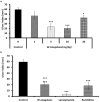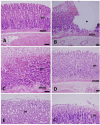Withania coagulans fruit extract antiulcerogenic effect: comparative study with lansoprazole and ranitidine in rats
- PMID: 40636368
- PMCID: PMC12238003
- DOI: 10.3389/fmed.2025.1544422
Withania coagulans fruit extract antiulcerogenic effect: comparative study with lansoprazole and ranitidine in rats
Abstract
Background: Peptic ulcer disease (PUD) arises from an imbalance between harmful factors like gastric acid and pepsin, and the protective mechanisms of the gastrointestinal lining, particularly the mucus-bicarbonate barrier. Standard treatments include proton pump inhibitors (e.g., lansoprazole) and histamine H₂-receptor antagonists (e.g., ranitidine), but these can have adverse effects. Withania coagulans, a plant used in Ayurvedic medicine, has traditionally been considered to have anti-ulcer properties. This study investigated the potential of W. coagulans fruit extract to protect against gastric ulcers, possibly via H₂ receptor antagonism.
Aim: To evaluate the gastroprotective effects and underlying mechanisms of W. coagulans fruit extract in a rat model of gastric ulcer.
Methods: A dose-response study was conducted using rats divided into six groups: naïve, ulcer control, and four groups treated with W. coagulans extract (1, 5, 10, or 20 mg/kg). Acidified ethanol was used to induce ulcers. In another experiment, pylorus-ligated rats were used to assess the extract's effect on gastric acid secretion in response to dimaprit, a histamine analog. For efficacy comparison, rats were pretreated with W. coagulans, lansoprazole, or ranitidine before ulcer induction. Gastric tissues were analyzed for biochemical markers, including cytokines, mucus, prostaglandin E2 (PGE2), and myeloperoxidase activity.
Results: The 10 mg/kg dose was most effective in reducing gastric ulceration. The extract reduced gastric acid secretion, like H₂ blockers. It also showed stronger antioxidant activity in gastric tissues compared to lansoprazole and ranitidine. Additionally, it reduced pro-inflammatory cytokines (IL-1β, TNF-α, IL-6), increased anti-inflammatory cytokines (IL-10, TGF-β), enhanced mucus and PGE2 production, and lowered myeloperoxidase activity.
Conclusion: Withania coagulans fruit extract at 10 mg/kg significantly protects against acid-induced gastric ulcers. Its effects are comparable to H₂ receptor blockers and include notable antioxidant and anti-inflammatory benefits.
Keywords: Wister rats; Withania coagulans; anti-inflammatory; anti-oxidative stress; gastric ulcer protection; histamine blocker; lansoprazole; ranitidine.
Copyright © 2025 Amir, Abu Damir, Ghazal-Aswad, Hassan, Adem, Ali, Bastaki, Adeghate and Adem.
Conflict of interest statement
The authors declare that the research was conducted in the absence of any commercial or financial relationships that could be construed as a potential conflict of interest.
Figures







Similar articles
-
Proton pump inhibitors for the prevention of non-steroidal anti-inflammatory drug-induced ulcers and dyspepsia.Cochrane Database Syst Rev. 2025 May 8;5(5):CD014585. doi: 10.1002/14651858.CD014585.pub2. Cochrane Database Syst Rev. 2025. PMID: 40337979
-
Effectiveness of the fruit of Rosa odorata sweet var. gigantea (Coll. et Hemsl.) Rehd. et Wils in the protection and the healing of ethanol-induced rat gastric mucosa ulcer based on Nrf2/NF-κB pathway regulation.J Ethnopharmacol. 2022 Jan 10;282:114626. doi: 10.1016/j.jep.2021.114626. Epub 2021 Sep 10. J Ethnopharmacol. 2022. PMID: 34517064
-
The Black Book of Psychotropic Dosing and Monitoring.Psychopharmacol Bull. 2024 Jul 8;54(3):8-59. Psychopharmacol Bull. 2024. PMID: 38993656 Free PMC article. Review.
-
Systemic pharmacological treatments for chronic plaque psoriasis: a network meta-analysis.Cochrane Database Syst Rev. 2021 Apr 19;4(4):CD011535. doi: 10.1002/14651858.CD011535.pub4. Cochrane Database Syst Rev. 2021. Update in: Cochrane Database Syst Rev. 2022 May 23;5:CD011535. doi: 10.1002/14651858.CD011535.pub5. PMID: 33871055 Free PMC article. Updated.
-
Systemic pharmacological treatments for chronic plaque psoriasis: a network meta-analysis.Cochrane Database Syst Rev. 2017 Dec 22;12(12):CD011535. doi: 10.1002/14651858.CD011535.pub2. Cochrane Database Syst Rev. 2017. Update in: Cochrane Database Syst Rev. 2020 Jan 9;1:CD011535. doi: 10.1002/14651858.CD011535.pub3. PMID: 29271481 Free PMC article. Updated.
References
-
- Udd M. The treatment and risk factors of peptic ulcer bleeding. Doctoral dissertation, vol. 88. Finland: University of Kuopio; (2007).
-
- Tooker LB, Dexter K. Zollinger-ellison syndrome: not your average peptic ulcer disease. Clin Rev. (2017) 27:32–4. Available at: https://cdn.mdedge.com/files/s3fs-public/Document/June-2017/CR02707032.P...
LinkOut - more resources
Full Text Sources
Research Materials

